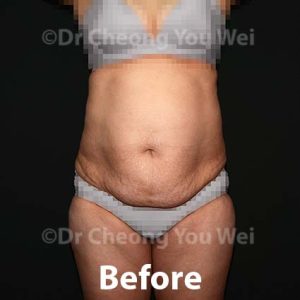Abdominoplasty (Tummy Tuck)




The aesthetic appearance of the abdomen can be affected by excessive fat deposit, redundant skin with multiple stretched marks, and budging of the abdomen. These conditions are usually caused by weight changes, pregnancy and aging process.
Excessive fat makes the abdomen looks full and round and affect the slim contour of the abdomen. Redundant skin in the abdomen hangs down like an apron, varying in length and size and can cause physical discomfort and unsightly appearance. In normal situation, the abdomen muscles are able to hold the internal viscera and maintain the flatness of the tummy. Weakened abdomen muscles are unable to hold and retain internal viscera in their normal position. The viscera bulge out under the weakened muscles and skin and cause a protuberant abdomen.
Liposuction, and to a certain extent diet and exercise, can remove fat deposit in the abdomen. However, these measures are unable to deal with redundant skin and muscle weakening and laxity.
Abdominoplasty (also known as tummy tuck) is a surgery that remove redundant skin and fat, and to repair and tighten the muscles in the abdomen. The objective is to create an abdomen that is flat, tight and slim. In tummy tuck, the abdomen skin is separated from the underlying structures and removed. The weakened abdominal muscle is repaired and tightened. Tummy tuck is usually combined with liposuction to remove excess abdominal fat.
The scar from a tummy tuck is located very low on the abdomen and is hidden by the panty. If present, scar from a previous Caesarean section surgery will be removed together with the excess skin.
There are different types of abdominoplasty surgery (see Surgical Technique). Which type of abdominoplasty to use depends on the severity of the redundant skin, the amount of excess fat and the extent of the laxity of the abdominal muscles.
Preparation
Surgery
Duration: 3-4 hours
Anaesthesia: General anaesthesia
Hospitalization: Daycare for mini-abdominoplasty. At least one-night stay for a standard abdominoplasty. 2-5 days for an extended abdominoplasty.
Recovery*: Back to work in 7 days, light exercise after 2 weeks, heavy exercise after 4 weeks.
* The actual recovery speed depends on the types of abdominoplasty and may vary from person to person.
Surgery Technique:
Skin markings are done before surgery. The skin in the lower abdomen is incised according to plan. The skin is separated from the underlying muscles and fascia. Repair and tightening of the abdomen muscles is performed. Excess skin is removed and the remaining skin is pulled down to closure the wound. The umbilicus will remain in its normal position in the abdomen. Abdominoplasty is frequently combined with a liposuction to remove excess fat.
There are different types of abdominoplasty and the decision to use which type of abdominoplasty depends on the amount of loose skin and the severity of weakened abdominal muscles.
Post-operative Care**
** The instructions in this list are only for general guidance. If you have any specific queries or concerns during the post-operative recovery, please contact the clinic for further advice.